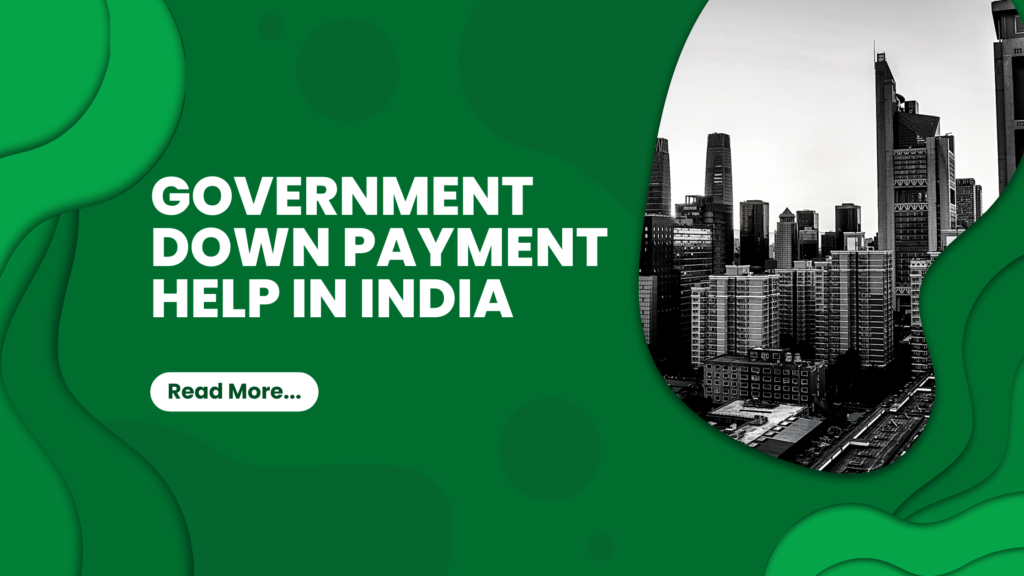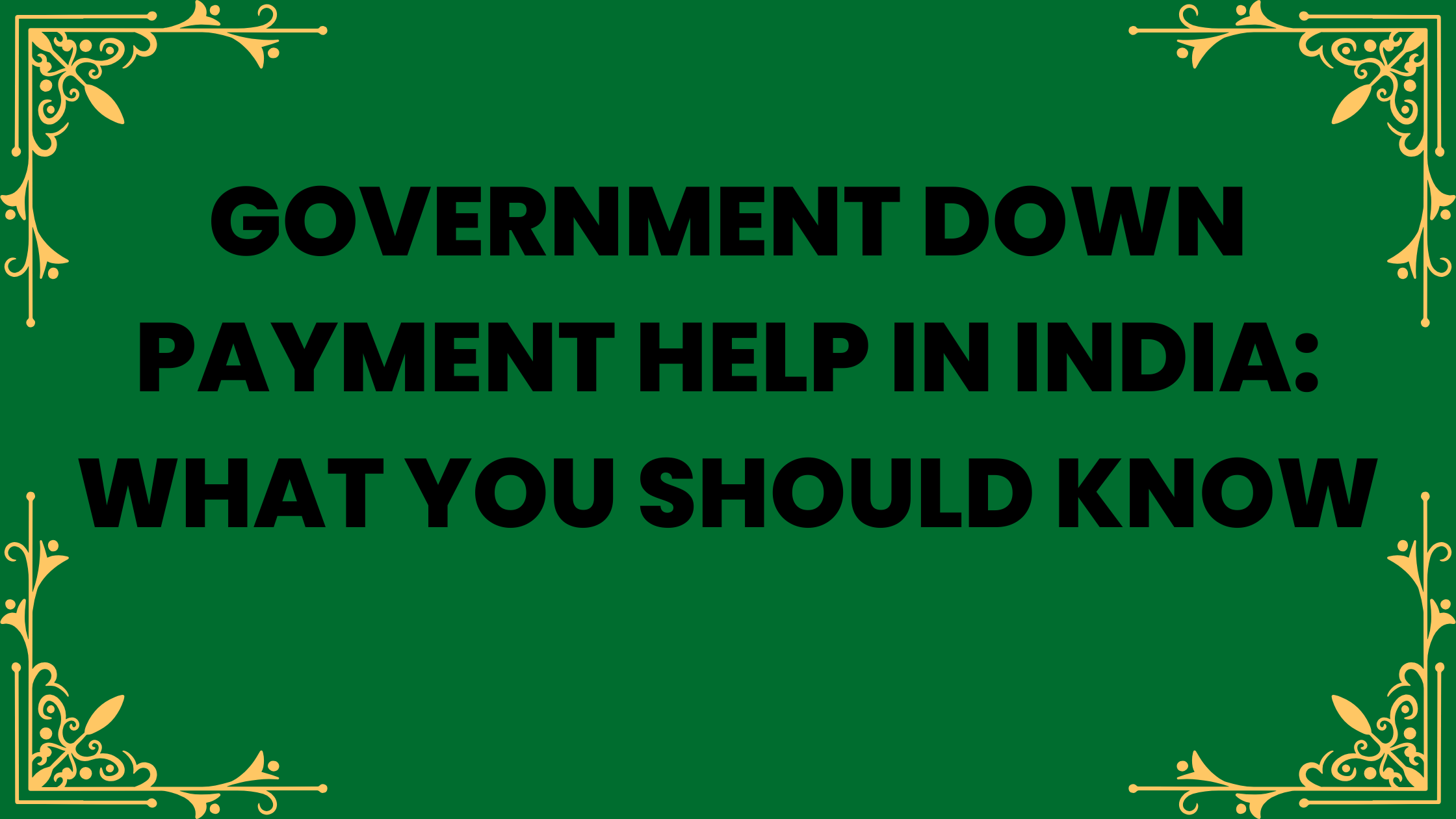Discover the Government Down Payment assistance programs in India, including PMAY, CLSS, and state-specific schemes. Learn how these programs can help you afford your dream home, eligibility criteria, application process, and tips to maximize your chances of approval.

Government Down Payment Help in India: What You Should Know
- Introduction
- The importance of down payments in home buying
- Why government assistance matters
- What Is a Down Payment?
- Understanding the concept of down payments
- Typical down payment requirements in India
- Why Are Down Payments a Barrier for Homebuyers?
- The financial challenges for first-time homebuyers
- High property prices and stagnant incomes
- Government Schemes for Down Payment Assistance
- Overview of key government programs
- Pradhan Mantri Awas Yojana (PMAY)
- Credit Linked Subsidy Scheme (CLSS)
- State-specific schemes for down payment assistance
- Eligibility for Government Down Payment Assistance
- Income brackets and limitations
- Target groups for assistance
- Regional variations in eligibility
- Pradhan Mantri Awas Yojana (PMAY)
- What is PMAY?
- How PMAY helps with down payments
- How to apply for PMAY benefits
- Credit Linked Subsidy Scheme (CLSS)
- Overview of CLSS under PMAY
- Eligibility for CLSS
- How much subsidy can you get through CLSS?
- State-Specific Programs
- Maharashtra’s MahaHousing Scheme
- Other states offering down payment assistance
- How to Apply for Down Payment Assistance
- Step-by-step guide for online applications
- Documents required for government programs
- Common mistakes to avoid during application
- Pros and Cons of Government Down Payment Assistance
- Benefits of using government help
- Potential limitations of government schemes
- How to Maximize Your Chances of Approval
- Ensuring eligibility before applying
- Tips to improve your chances of success
- Common Misconceptions About Down Payment Help
- Myth 1: Only low-income individuals can apply
- Myth 2: The process is too complicated
- Alternatives to Government Assistance
- Personal loans for down payments
- Crowdfunding options for first-time buyers
- Future of Down Payment Assistance in India
- Expected policy changes
- Will more people qualify for government help?
- Conclusion
- Summary of key points
- Encouragement to explore available assistance options
- FAQs
Government Down Payment Help in India: What You Should Know
Buying a home is a dream for many, but the biggest obstacle for most potential homeowners in India is the down payment. It’s a significant amount of money, and many people struggle to gather the required funds. Fortunately, the government offers several programs that provide financial aid to help people with their down payments. In this article, we’ll dive into what you need to know about these programs and how you can benefit from them.
Introduction to Government Down Payment
The Importance of Government Down Payments in Home Buying
A down payment is an upfront cost paid when purchasing a property. It typically amounts to 10-20% of the total value of the property, depending on the financial institution’s requirements. This initial sum is crucial as it determines your eligibility for home loans and affects the interest rate you’ll be offered. A larger down payment typically means smaller monthly installments and lower interest over the life of the loan.
Why Government Down Payment Assistance Matters
With property prices steadily increasing in India, the requirement for a substantial down payment can be a barrier to homeownership. Government Down Payment assistance in this area helps people, especially first-time buyers, make their dreams of owning a home a reality by providing financial support for the initial cost.
What Is a Government?
Understanding the Concept of Down Payments
A down payment is the amount you pay upfront when purchasing a house. The rest of the payment is usually covered by a home loan. In India, banks generally ask for a minimum down payment of 10-20% of the property’s price, with the rest covered by the loan.
Typical Down Payment Requirements in India
In most cases, buyers need to put down at least 10% of the property value, though this varies based on the bank and the location of the property. For premium properties, the down payment percentage might be higher.
Why Are Down Payments a Barrier for Homebuyers?
The Financial Challenges for First-Time Homebuyers
For first-time buyers, especially those with middle or lower incomes, accumulating enough savings for a down payment can take years. The cost of living in cities is high, and many buyers find it difficult to save after covering day-to-day expenses.
High Property Prices and Stagnant Incomes
Property prices in major cities like Mumbai, Delhi, Nagpur and Bangalore have skyrocketed over the years, while wages have not increased proportionally. This imbalance makes it challenging for buyers to meet down payment requirements without some form of external financial help.
Government Schemes for Down Payment Assistance
Overview of Key Government Programs
To address the issue of down payments, the government has introduced various programs aimed at reducing the financial burden for homebuyers.
Pradhan Mantri Awas Yojana (PMAY)
PMAY is a flagship scheme that aims to provide affordable housing to all by 2022. One of its key components is offering financial assistance to those struggling to make down payments.
Credit Linked Subsidy Scheme (CLSS)
Under PMAY, the CLSS helps homebuyers with a subsidy on the interest rate, thus reducing the overall cost of the home loan and easing the burden of down payments.
State-Specific Schemes for Down Payment Assistance
Different states in India, such as Maharashtra and Tamil Nadu, have their own schemes that complement the central government’s efforts. These state-specific schemes often provide additional financial support for down payments.
Eligibility for Government Down Payment Assistance
Income Brackets and Limitations
The government’s assistance programs are mainly designed to help lower-income and middle-income groups. Eligibility for these programs is often determined by the applicant’s income, with limits placed on how much one can earn to qualify for assistance.
Target Groups for Assistance
Typically, these programs target first-time homebuyers, economically weaker sections (EWS), and low-income groups (LIG). Some schemes also provide assistance to middle-income groups (MIG).
Regional Variations in Eligibility
The eligibility criteria for government programs can differ from state to state. Some states offer more extensive assistance, while others may have stricter guidelines.
Pradhan Mantri Awas Yojana (PMAY)
What is PMAY?
The Pradhan Mantri Awas Yojana is a government initiative that aims to provide affordable housing for all. It includes various financial incentives, such as down payment assistance, to make homeownership accessible.
How PMAY Helps with Down Payments
Under PMAY, eligible homebuyers can receive a subsidy on their home loans, which reduces the amount of money they need to pay upfront as a down payment. The subsidy varies depending on the buyer’s income group.
How to Apply for PMAY Benefits
The application process for PMAY is straightforward. You can apply online through the official PMAY website or visit the nearest Common Service Centre (CSC) to complete the application in person.
Credit Linked Subsidy Scheme (CLSS)
Overview of CLSS Under PMAY
The CLSS under PMAY provides an interest subsidy on home loans, reducing the effective interest rate. This reduction, in turn, decreases the total loan amount, making it easier for buyers to manage down payments.
Eligibility for CLSS
Eligibility for CLSS is based on income. Individuals earning up to ₹18 lakh annually are eligible for the scheme, with different interest subsidies offered to different income brackets.
How Much Subsidy Can You Get Through CLSS?
The amount of subsidy you can receive depends on your income group. The maximum subsidy can go up to ₹2.67 lakh, making a significant dent in your down payment requirements.
State-Specific Programs
Maharashtra’s MahaHousing Scheme
Maharashtra offers additional benefits to those buying homes through its MahaHousing scheme. This state-level program provides further down payment assistance to eligible buyers.
Other States Offering Down Payment Assistance
Other states like Gujarat and Karnataka also have programs that offer down payment help. These programs vary in terms of eligibility and the amount of assistance provided.
How to Apply for Down Payment Assistance
Step-by-Step Guide for Online Applications
- Visit the official government website of the scheme you are interested in.
- Fill out the application form with accurate details.
- Upload the required documents (proof of income, identity, and residence).
- Submit the form and wait for a confirmation email or message.
Documents Required for Government Programs
- Proof of income (salary slips, bank statements)
- Proof of residence
- Aadhaar card or other identity proof
- Property documents
Common Mistakes to Avoid During Application
Ensure that all the details you provide are correct, as discrepancies can lead to rejection. Double-check your documents before submission to avoid delays.
Pros and Cons of Government Down Payment Assistance
Benefits of Using Government Help
- Reduces the financial burden of making a large down payment.
- Lowers monthly mortgage payments through interest subsidies.
- Encourages homeownership for lower-income and middle-income families.
Potential Limitations of Government Schemes
- Eligibility criteria may exclude some buyers.
- Limited availability of affordable housing in major cities.
- Long processing times due to high demand.
How to Maximize Your Chances of Approval
Ensuring Eligibility Before Applying
Before applying, make sure you meet the income requirements and other criteria for the program you’re interested in. Doing so will save time and increase your chances of approval.
Tips to Improve Your Chances of Success
- Keep your financial documents up to date.
- Apply early, as these schemes often work on a first-come, first-served basis.
- Consult a housing consultant if you’re unsure about the process.
Common Misconceptions About Down Payment Help
Myth 1: Only Low-Income Individuals Can Apply
While many schemes are designed for lower-income groups, several programs also cater to middle-income individuals.
Myth 2: The Process is Too Complicated
Although the application process may seem daunting, most of it can be completed online. With the right documents, it’s relatively straightforward.
Alternatives to Government Assistance
Personal Loans for Down Payments
If you don’t qualify for government assistance, you can consider taking a personal loan to cover your down payment. However, be mindful of the interest rates and repayment terms.
Crowdfunding Options for First-Time Buyers
Some buyers are turning to crowdfunding platforms to raise the funds for their down payments. This option can be viable, but it depends on your network and ability to attract supporters.
Future of Down Payment Assistance in India
Expected Policy Changes
As housing remains a key issue, the government may introduce more inclusive policies that expand eligibility and increase financial aid for down payments.
Will More People Qualify for Government Help?
Given the growing demand for affordable housing, it is likely that future schemes will cover a wider range of income groups and offer more comprehensive assistance.
Conclusion
Government down payment assistance schemes have become a lifeline for many aspiring homeowners in India. Whether through PMAY, CLSS, or state-specific programs, these initiatives provide the financial boost needed to make homeownership more accessible. If you’re struggling to save for a down payment, these programs are worth exploring.
FAQs
- What is the maximum subsidy I can get under PMAY?
- The maximum subsidy is ₹2.67 lakh, depending on your income group.
- Is PMAY available for second-time homebuyers?
- No, PMAY is only available for first-time homebuyers.
- Can I apply for multiple down payment assistance programs?
- Yes, you can apply for both central and state government schemes if you meet the eligibility criteria.
- How long does it take to get approval for down payment assistance?
- Approval times vary, but it typically takes a few weeks to a couple of months.
- Can NRIs apply for down payment assistance under PMAY?
- Yes, NRIs can apply as long as they meet the income and eligibility criteria.


2 thoughts on “Government Down Payment Help in India: What You Should Know”